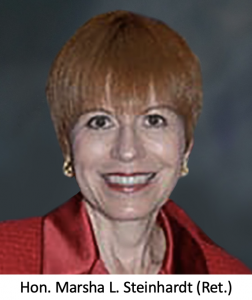MEDICAL MALPRACTICE SETTLEMENTS IN THE TIME OF COVID – A FIRSTHAND ACCOUNT
Posted on Apr 01, 2021 |Publications
by Hon. Marsha L. Steinhardt (Ret.) | April 2021
A year ago, on Tuesday, March 17th while serving as a Justice of the Supreme Court, Kings County, I, along with all my colleagues, was the recipient of an alarming email – “all Judges are directed to remain at home until further notice.” The Novel Corona Virus 19 pandemic (COVID-19) had blown its dreaded breath at the Court System and my daily routine, as Judge in charge of the medical malpractice conference and settlement part, abruptly came to a sudden halt.
By Friday of that week my Law Secretary and I had arrived with a plan. We immediately got in touch with the attorneys we knew, plaintiffs and defendants who had cases pending before me, via email or phone and suggested conferencing with the Court, remotely. It was an idea met with universal enthusiasm. Shortly thereafter, the court system authorized remote conferencing.
Ultimately, with many stops and starts, our plan took shape. Initially we recommended that the attorneys review their files and make a list of all the cases pending in the Part. They were to forward the list to the court, and we would arrange for a conference date, taking into consideration the convenience of all the participants involved. By virtue of everyone being in “lock-down” mode, the hour of the day when we began was not a factor and, often, we would commence our discussions in the middle of the afternoon, leaving time for other remote activities.
We were inundated with requests. In the beginning months, many of the cases were nowhere near the trial stage, but still in the early moments of discovery. Frequently, these cases found a path to an early resolution during our conferences, as both sides were eager to dispose of the matter without too much time being needlessly spent on depositions, and other modes of discovery. The attorneys and I were able, with little fanfare, to cut to the “heart of the matter” and to get meaningful conversations going. After one or two conferences, everyone was able to agree on “the number” and many attorneys were spared the tedium of the discovery process.
The majority of the cases appearing on the remote conference calendar were already well along on the path to trial. Many had already been conferenced numerous times and were trial ready, or “to be assigned” to a judge to be placed on the trial date calendar, but no one was being assigned anywhere at that point and these matters became a priority. Conferences took place, many adjournments were frequently necessary to continue discussions, but ultimately, many of these matters resolved.
Although the remote set up took a bit of getting used to and working from home was distracting in the beginning, eventually everyone seemed to get the hang of it. The same basic negotiating skills, used daily in the courthouse setting, reemerged immediately. Listening, patience and keeping confidences remained at the forefront of every discussion. Knowing that the lawyers were forthcoming made the settlement process a pleasant experience. As I recently read in a novel, “a person who trusts can be trusted.”
It appears that the courts will be resuming jury trials in the immediate future. To the best of my knowledge the simple, bifurcated, liability only matters will be on the trial dockets, at least in Kings County. These are cases that must be concluded within a week. In my many years on the bench, I have not come across one medical malpractice case that falls into that category. Numerous, expensive experts make up the majority of the witness lists on both sides of the aisle.
Although there is a light at the end of the trial tunnel, it seems, in the opinion of this humble author, that when speaking of medical malpractice, that light is still merely flickering. At this moment in time, a negotiated settlement appears to be the most viable alternative. To not be talking at all seems unwise. To be talking in the mediation setting, should, at minimum, bring the parties closer, with the goal of resolution perhaps a conference away.
At this moment in time and for the foreseeable future, using digital conferencing to resolve medical malpractice matters is a secure, time efficient and expeditious way to bring a case to resolution. This past year has proven just that. The use of Zoom and other video conferencing platforms to settle disputes unequivocally works.
I retired from the bench on December 31, 2020, after a strange year spent at home on my computer talking to lawyers about settlements on a daily basis. Many of the cases, as I like to say, “went away.” I, on the other hand, have not! I am currently a neutral with NAM (National Arbitration and Mediation.) I hope that my thoughts and opinions may encourage you to seek a speedy end to some pending matters.
__________________________________________________________________________________________________
Hon. Marsha L. Steinhardt (Ret.) is a member of NAM's (National Arbitration and Mediation) Hearing Officer Panel. Her remarkable 31-year judicial career includes 26 years spent as a Justice of the Supreme Court. In 2011, she was assigned to the Medical Malpractice Trial Readiness Part (MMTRP), Kings County, where she conferenced every post Note of Issue medical malpractice case in Brooklyn, resulting in the resolution of a significant number prior to trial. Early on, while on the Supreme Court bench, she presided over many various types of cases, including personal injury, product liability, premises liability, and several matters involving complex commercial litigation. Respected by both plaintiffs and defendants alike, Judge Steinhardt is known for her deep understanding of medical practices, processes and terminology that allows her to fully assess and evaluate the issues of the case. Justice Steinhardt is available to arbitrate and mediate cases throughout the State of New York.
